What is a diner?
Some insist that in order for a restaurant to qualify as a diner, it must be a prefabriacted structure with a counter and stools which swivel and are bolted to the floor. There are others who refine the distinction even further and insist on the judicious use of stainless steel, inside and out. Others require the place to be long and narrow, and not too big. Others appoint diner status based on the menu and prices. "A diner serves unpretentious, home cooked meals for a reasonable price, and is generally family-owned and operated," some may say. "If it doesn't serve breakfast at any hour of the day, it's not a diner." Nod suportively, but don't except those words as fact.
Webster's Dictionary defines a diner as "a restaurant in the shape of a railroad car." The word "diner" is a derivative of "dining car" and reflects the stylings that diner manufacturers borrowed from railroad cars. Some people mistakingly believe that all diners are converted railroad cars or trolleys. While in fact some were, the vast majority of diners were built to be diners and are not salvaged rolling stock.
Personally, I haven't exactly made up my mind what distinguishes an ordinary roadside restaurant from a diner. Yes, if the builder generously employs shiny materials such as stainless steel, porcelin, tile, and glass, in bright colors, with art deco patterns, it's probably a diner. Can a storefront restaurant be considered a diner or must it be a one story, freestanding structure? Does any place with jukeboxes and 50's memorabilia qualify? There is no doubt in my mind that the debate will rage on for years to come.
Another interesting issue is what distinguishes a "classic" diner from a modern one. In the early 1960's, with the growing popularity of fast food chain restaurants, the diner industry underwent major changes. Diners wanted to get away from the fast food image which resulted in a trend toward more conservative designs. New diners emerged with first with Colonial and then Mediterranean stylings and stainless steel virtually disappeared. Most people who are "diner fans" do not hold the same enthusiasm for these later designs, and often consider them a bit "tacky." Jane and Michael Stern have devoted a chapter to diners resembling Grecian palaces in their book
The Enclyopedia of Bad Taste, and I can't help but agree with much of their commentary on the subject. Still, I find myself facinated by diners of all styles.
Diner ManufacturersThere have been dozens of companies which have manufacturered diners over the years. The difference between a diner built by one manfacturer and one built by another is much like the difference between two cars of different makers, except that the diner builder didn't stamp his name on the grill. If you look carefully enough, most diners have a small nameplate somewhere in the interior identifying the company that built it, but they are often small and not easy to find. If you ever become as obsessed with diners as I am, you may very well find yourself developing a skill at identifying the manufactuerer of any given diner at a glance. To get you started, I have developed a list of what I condsier the major manufactuers in the "golden age of diners." A few of these are still in operation today.
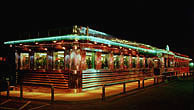 Jerry O'Mahony, Inc, Elizabeth, NJ, 1913-1956, built many different style diners and was a leader in diner production for several decades. The oldest surviving O'Mahony's include Ted's Diner in Milford, Mass and Max's Grill in Harrison New Jersey. Both feature barrel roofs, bright red porcelin exeriors, and cream-colored lettering. Mickey's Dining Car , c. 1937, in St. Paul, Minnesota, is the only O'Mahony listed on the National Register of Historic Places and features a railroad-car-like monitor roof. Following the trend of other diner builders, O'Mahony introduced stainless steel exteriors in the late 1940's which predominated until the company went out of business in 1956. In the early 50's, several larger double-unit O'Mahony's were produced including the L-shaped Harris Diner in East Orange, New Jersey. One of the last diners built by this manufacturer was the exceptionally long Mayfair Diner in Northeast Philadelphia.
Jerry O'Mahony, Inc, Elizabeth, NJ, 1913-1956, built many different style diners and was a leader in diner production for several decades. The oldest surviving O'Mahony's include Ted's Diner in Milford, Mass and Max's Grill in Harrison New Jersey. Both feature barrel roofs, bright red porcelin exeriors, and cream-colored lettering. Mickey's Dining Car , c. 1937, in St. Paul, Minnesota, is the only O'Mahony listed on the National Register of Historic Places and features a railroad-car-like monitor roof. Following the trend of other diner builders, O'Mahony introduced stainless steel exteriors in the late 1940's which predominated until the company went out of business in 1956. In the early 50's, several larger double-unit O'Mahony's were produced including the L-shaped Harris Diner in East Orange, New Jersey. One of the last diners built by this manufacturer was the exceptionally long Mayfair Diner in Northeast Philadelphia.
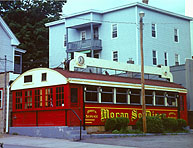 Worcester Lunch Car Company, Worcester, MA, 1906-1961, for the most part built a small, handcrafted diner with a porcelin exterior and hardwood interior. Many Worcesters feature gothic lettering painted on the porcelin front panels and colorfully striped awnings. The Boulevard Diner and the Miss Worcester Diner, both located in the city of Worcester, Mass, are fine examples, as is the colorful Moran Square Diner in Fitchburg, Mass, which sports unusual 9-pane windows and raised wood panels at one end. Worcester interiors were often adorned with marble countertops, stainless steel panels shaped into starburst patterns, and hardwood booths as you can see in Lamy's Diner now located inside the Henry Ford Museum in Dearborn, Michigan. The craftmanship of Worcester diners is unsurpassed. It is no wonder that they have become a favorite subject of many artists.
Worcester Lunch Car Company, Worcester, MA, 1906-1961, for the most part built a small, handcrafted diner with a porcelin exterior and hardwood interior. Many Worcesters feature gothic lettering painted on the porcelin front panels and colorfully striped awnings. The Boulevard Diner and the Miss Worcester Diner, both located in the city of Worcester, Mass, are fine examples, as is the colorful Moran Square Diner in Fitchburg, Mass, which sports unusual 9-pane windows and raised wood panels at one end. Worcester interiors were often adorned with marble countertops, stainless steel panels shaped into starburst patterns, and hardwood booths as you can see in Lamy's Diner now located inside the Henry Ford Museum in Dearborn, Michigan. The craftmanship of Worcester diners is unsurpassed. It is no wonder that they have become a favorite subject of many artists.
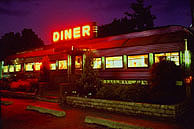 Silk City Diners (Paterson Vehicle Company), Paterson, NJ, 1927-1964, built a fine-crafted diner in a variety of styles . Exteriors typically used a combination of stainless steel and porcelin in many different color schemes and often displayed the diner's name on a large horizontal porcelin stripe. Two Silk City diners are listed on the National Register of Historic Places, the Clarksville Diner in Decorah, Iowa, and the Village Diner in Red Hook, New York. All Silk City's that I have seen which were built before the mid-50's, have a similar monitor style roof. Later Silk City's feature a flat roofline and an unusually large vestibule, as does the Martindale Chief Diner located just off the Taconic Parkway in upstate New York.
Silk City Diners (Paterson Vehicle Company), Paterson, NJ, 1927-1964, built a fine-crafted diner in a variety of styles . Exteriors typically used a combination of stainless steel and porcelin in many different color schemes and often displayed the diner's name on a large horizontal porcelin stripe. Two Silk City diners are listed on the National Register of Historic Places, the Clarksville Diner in Decorah, Iowa, and the Village Diner in Red Hook, New York. All Silk City's that I have seen which were built before the mid-50's, have a similar monitor style roof. Later Silk City's feature a flat roofline and an unusually large vestibule, as does the Martindale Chief Diner located just off the Taconic Parkway in upstate New York.
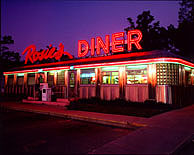 Paramount Diners, Oakland, NJ, 1932-present, was the first manufacturer to introduce an all-stainless-steel exterior. Paramount diners featured a distinctive curved roofline, and rounded glass block corners. Many of its earlier diners, such as White Manna Hamburgers in Hackensack, New Jersey, are adorned with a "wainscoating" of beveled vertical porcelin panels. In the mid-40's, Paramount introduced the all-stainless exterior. Rosie's Diner now in Rockford, Michigan is a glistening example.
Paramount Diners, Oakland, NJ, 1932-present, was the first manufacturer to introduce an all-stainless-steel exterior. Paramount diners featured a distinctive curved roofline, and rounded glass block corners. Many of its earlier diners, such as White Manna Hamburgers in Hackensack, New Jersey, are adorned with a "wainscoating" of beveled vertical porcelin panels. In the mid-40's, Paramount introduced the all-stainless exterior. Rosie's Diner now in Rockford, Michigan is a glistening example.
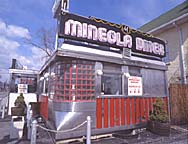 Mountain View Diners, Singac, NJ, 1939-1957, was a very aggressive marketer in the early 1950's, shipping diners to buyers all over the country. Their trademark was a unique corner detail know as the "cowcatcher" which can be seen on the Mineola Diner in Mineola, New York and O'Rourke's in Middletown, Connecticut, both built in 1946.
Mountain View Diners, Singac, NJ, 1939-1957, was a very aggressive marketer in the early 1950's, shipping diners to buyers all over the country. Their trademark was a unique corner detail know as the "cowcatcher" which can be seen on the Mineola Diner in Mineola, New York and O'Rourke's in Middletown, Connecticut, both built in 1946.
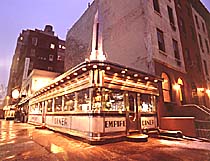 Fodero Dining Car Company, Bloomfield, NJ, 1933-1981, built many exceptional diners through out its long history. Perhaps the most famous Fodero is the 1946 Empire Diner in Manhattan. Fodero built some noteably large diners in the 50's including the Ingleside Diner in Thorndale, Pennsylvania.
Fodero Dining Car Company, Bloomfield, NJ, 1933-1981, built many exceptional diners through out its long history. Perhaps the most famous Fodero is the 1946 Empire Diner in Manhattan. Fodero built some noteably large diners in the 50's including the Ingleside Diner in Thorndale, Pennsylvania.
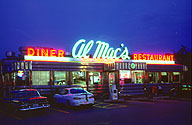 DeRaffle Manufacturing Company, New Rochelle, NY, 1933-present, is currently the largest surviving diner manufacturer. Al Mac's Diner in Fall River, Mass, shows off the company's superb stainless steel work and displays one of most magnificent neon signs I have ever seen. DeRaffle was one of a few manufacturers to build diners in the "space-age" style. In the Parkway Diner in Stamford, Connecticut, we see a stainless steel diner which looks much like the companies earlier models, except for the vestibule, which is encircled by a futuristic flared overhang with recessed lighting. Later DeRaffle's, such as New Harvest Natural Foods in Suffern, New York and the Silver Star Diner in Allentown, Pennsylvania, exhibit more radical futuristic stying.
DeRaffle Manufacturing Company, New Rochelle, NY, 1933-present, is currently the largest surviving diner manufacturer. Al Mac's Diner in Fall River, Mass, shows off the company's superb stainless steel work and displays one of most magnificent neon signs I have ever seen. DeRaffle was one of a few manufacturers to build diners in the "space-age" style. In the Parkway Diner in Stamford, Connecticut, we see a stainless steel diner which looks much like the companies earlier models, except for the vestibule, which is encircled by a futuristic flared overhang with recessed lighting. Later DeRaffle's, such as New Harvest Natural Foods in Suffern, New York and the Silver Star Diner in Allentown, Pennsylvania, exhibit more radical futuristic stying.
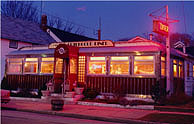 Kullman Industries, Inc., Avenel, NJ, 1927-Present, was also a builder of space-age style diners. The 1964 Market Diner in Manhattan with its zig-zag roofline exemplifies the genre. In its earlier history, Kullman produced a great variety of diner styles, and was certainly one of the undisputed masters of stainless. A fine example of this company's craftsmanship can be found on the northern fork of long island where you will find the Cutchogue Diner built in the 1940's. Kullman was the first manufacturer to revive the stainless steel diner in the 1980's. Since then it has built many diners with the classic styling such as the Americana Diner in Shrewsbury, NJ
Kullman Industries, Inc., Avenel, NJ, 1927-Present, was also a builder of space-age style diners. The 1964 Market Diner in Manhattan with its zig-zag roofline exemplifies the genre. In its earlier history, Kullman produced a great variety of diner styles, and was certainly one of the undisputed masters of stainless. A fine example of this company's craftsmanship can be found on the northern fork of long island where you will find the Cutchogue Diner built in the 1940's. Kullman was the first manufacturer to revive the stainless steel diner in the 1980's. Since then it has built many diners with the classic styling such as the Americana Diner in Shrewsbury, NJ
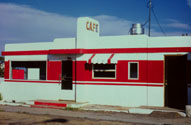 Valentine Manufacturing Company, Wichita, KS, 1938-1974, in its time was the only signifcant diner manufacturer outside the Northeast. Valentine built a small, boxy diner which was radically different than any other manufacurer's. The vast majority of factory-built diners west of the Missisippi were produced by this company. Their 1940's models such as the Twin Arrows Cafe near Flagstaff, Arizona or Suzie Q's in Mason City, Iowa, were tiny, 10-stool operations with an L-shaped counter and often featured a take-out window. In the 1950's, some larger units were produced such as Cindy's Diner in Fort Wayne, IN.
Valentine Manufacturing Company, Wichita, KS, 1938-1974, in its time was the only signifcant diner manufacturer outside the Northeast. Valentine built a small, boxy diner which was radically different than any other manufacurer's. The vast majority of factory-built diners west of the Missisippi were produced by this company. Their 1940's models such as the Twin Arrows Cafe near Flagstaff, Arizona or Suzie Q's in Mason City, Iowa, were tiny, 10-stool operations with an L-shaped counter and often featured a take-out window. In the 1950's, some larger units were produced such as Cindy's Diner in Fort Wayne, IN.
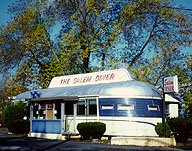 Sterling Diners (J.B. Judkins Company), Merrimac, MA, 1936-1942 One of the most distintive diner models every built, was manufactured by the J.B. Judkins Company. Although Sterling Diners built many diners of conventional styling including the Crosser Diner in Lisbon, Ohio, their most memorable achievement was the streamliner model which mimicked the streamlined railroad cars of its day and featured either one or two rounded ends. The Salem Diner in Salem, MA, is a "single ended" model.
Sterling Diners (J.B. Judkins Company), Merrimac, MA, 1936-1942 One of the most distintive diner models every built, was manufactured by the J.B. Judkins Company. Although Sterling Diners built many diners of conventional styling including the Crosser Diner in Lisbon, Ohio, their most memorable achievement was the streamliner model which mimicked the streamlined railroad cars of its day and featured either one or two rounded ends. The Salem Diner in Salem, MA, is a "single ended" model.

 Free Forum Hosting
Free Forum Hosting